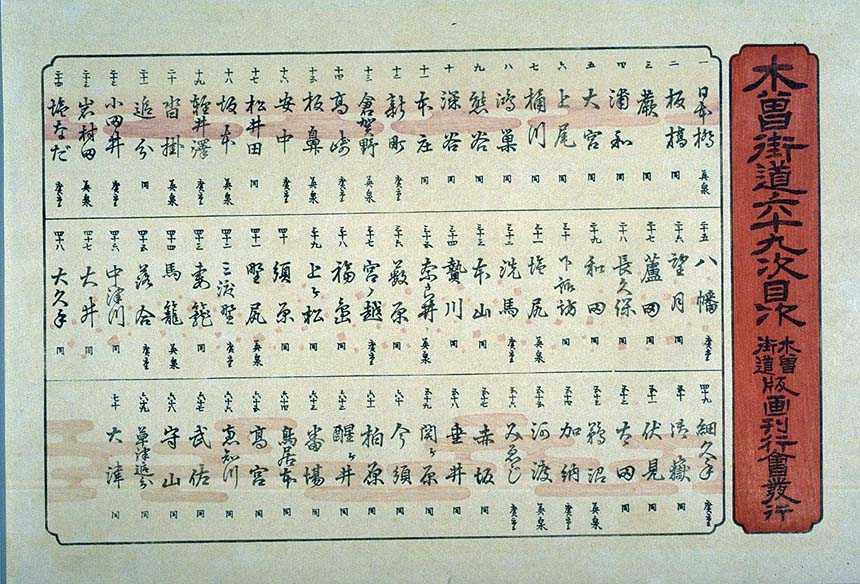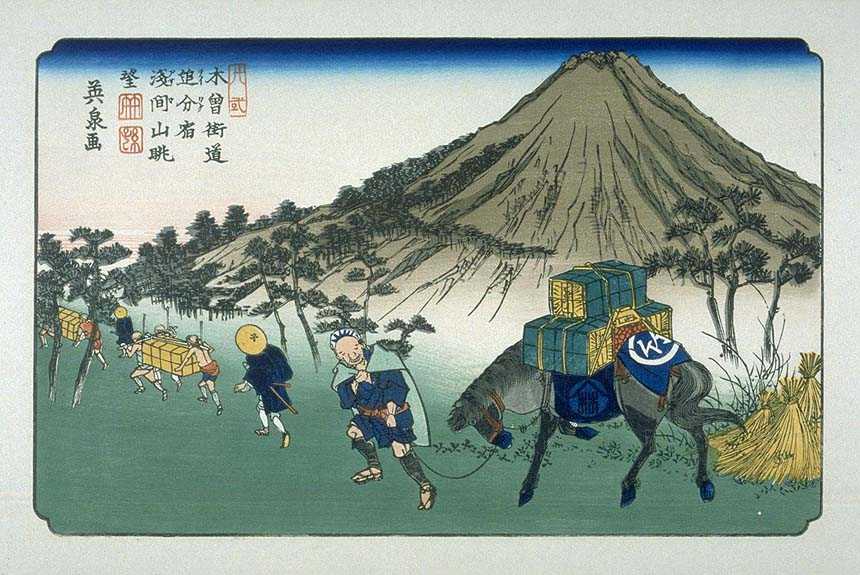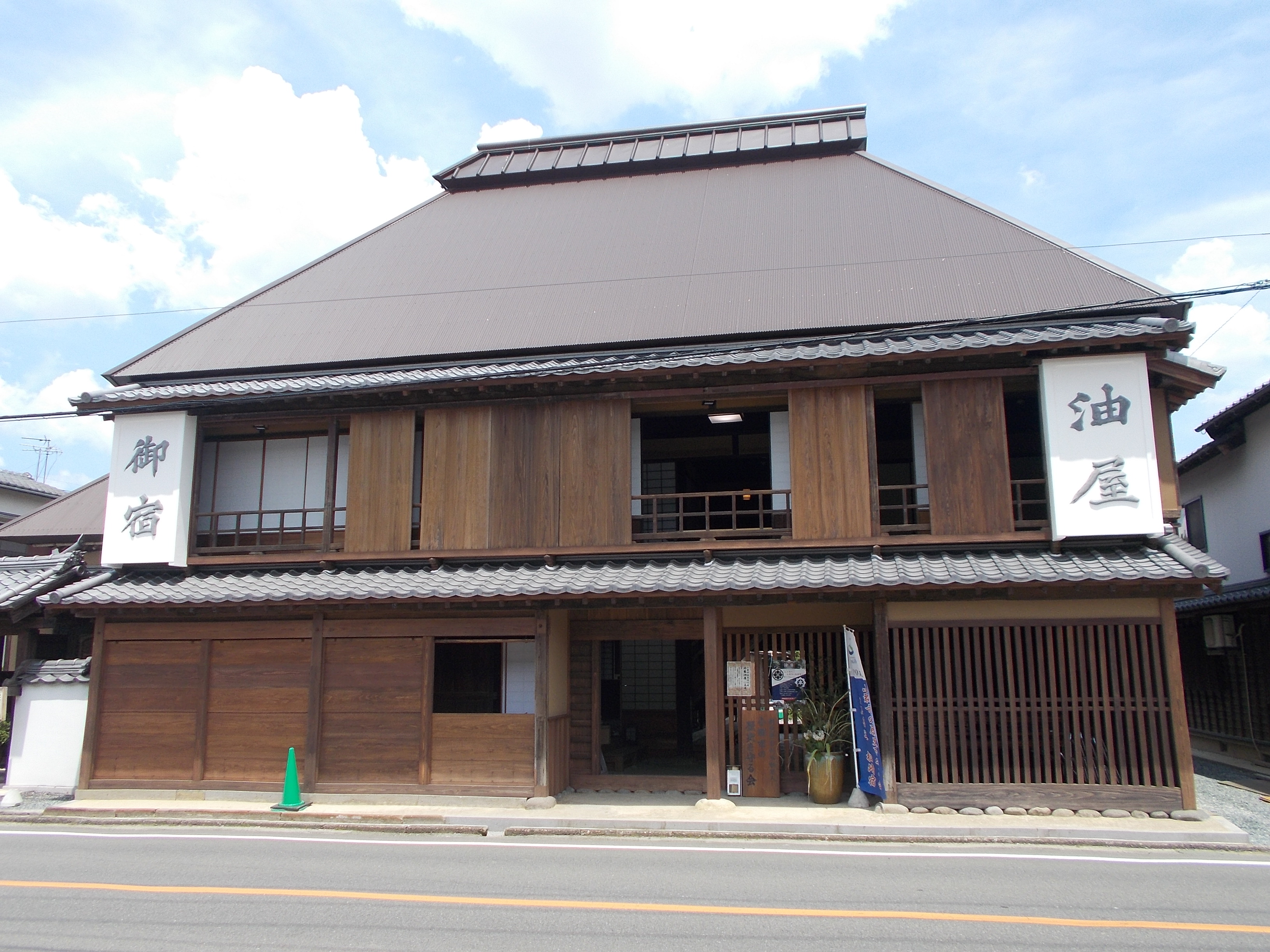|
Sekigahara-juku
was the fifty-eighth of the sixty-nine stations of the Nakasendō connecting Edo with Kyoto in Edo period Japan. It is located in former Mino Province in what is now part of the town of Sekigahara, Fuwa District, Gifu Prefecture, Japan. History Sekigahara is a strategically important location as is located at the entrance to a narrow pass that was the only land route between Mino Province and Ōmi Province. The name came from a barrier and checkpoint called the "Kuwano-no-seki", which existed since the Asuka period to guard the approaches to the capital from the east. The checkpoint fell out of use in then Heian period, but was received by the Tokugawa Shogunate. The village was also at a junction of the Nakasendō with the Hokkoku Kaidō towards the Sea of Japan and the Ise Kaidō to the Ise Grand Shrine.Nakasendo Seki ... [...More Info...] [...Related Items...] OR: [Wikipedia] [Google] [Baidu] |
The Sixty-nine Stations Of The Kiso Kaidō
The or ''Sixty-nine Stations of the Kiso Road'', is a series of ''ukiyo-e'' works created by Utagawa Hiroshige and Keisai Eisen. There are 71 total prints in the series (one for each of the 69 shukuba, post stations and Nihonbashi; Nakatsugawa-juku has two prints). The common name for the Kisokaidō is "Nakasendō" so the series is sometimes referred to as the ''Sixty-nine Stations of the Nakasendō''. It is a follow-up to Hiroshige's ''The Fifty-three Stations of the Tōkaidō'' and he produced 47 of the prints, with Eisen being responsible for the rest.Hiroshige - Kisokaido www.hiroshige.org.uk. Accessed November 1, 2017. The series was published by Iseya Rihei (Kinjudō) from .Forrer The Nakasendō The Nakasendō was one of the Edo Five Routes, Five Routes con ...[...More Info...] [...Related Items...] OR: [Wikipedia] [Google] [Baidu] |
Imasu-juku
260px, site of Imasu-juku was the fifty-ninth of the sixty-nine stations of the Nakasendō connecting Edo with Kyoto in Edo period Japan. It is located in former Mino Province in what is now part of the town of Sekigahara, Fuwa District, Gifu Prefecture, Japan. History Imasu-juku was located on the ancient Tōsandō highway connecting the capital of Heian-kyō with the provinces of eastern Japan, and near the border of Ōmi Province with Mino Province. In the early Edo period, the system of post stations on the Nakasendō was formalized by the Tokugawa shogunate in 1602, and it was a stopping place for traveling merchants () who originated from Ōmi Province. It was also on the ''sankin-kōtai'' route used by various western ''daimyō'' to-and-from the Shogun's court in Edo. It was also on the Kurihangaidō (九里半街道), [...More Info...] [...Related Items...] OR: [Wikipedia] [Google] [Baidu] |
Tarui-juku
260px, modern Tarui-juku was the fifty-seventh of the sixty-nine stations of the Nakasendō connecting Edo with Kyoto in Edo period Japan. It is located in former Mino Province in what is now part of the town of Tarui, Fuwa District, Gifu Prefecture, Japan. History Tarui-juku is one of the oldest settlements on the Nakasendō. It is mentioned in 12th century accounts, but is probably much older, as it grew up around the ''ichinomiya'' of Mino Province (the Nangū Taisha and the Nara period provincial capital). Its location made it an important market town, as it was also located on an intersection of the Nakasendō with the Minoji, a 60 kilometer secondary road which connected the Nakasendō with the Tōkaidō at Miya-juku, with nine post stations. Nakasendo Tarui-juku . Ibisoku Co., Ltd. Accessed July 11, 2007. Th ... [...More Info...] [...Related Items...] OR: [Wikipedia] [Google] [Baidu] |
Shukuba
were Stage station, staging post stations during the Edo period in Japan, generally located on one of the Edo Five Routes or one of its sub-routes. They were also called ''shuku-eki'' (宿駅). These stage stations, or "" developed around them, were places where travelers could rest on their journey around the nation. They were created based on policies for the transportation of goods by horseback that were developed during the Nara period, Nara and Heian period, Heian periods. History These stations were first established by Tokugawa Ieyasu shortly after the end of the Battle of Sekigahara. The first stations were developed along the Tōkaidō (road), Tōkaidō (followed by stations on the Nakasendō and other routes). In 1601, the first of the Tōkaidō's 53 Stations of the Tōkaidō, fifty-three stations were developed, stretching from Shinagawa-juku in Edo to Ōtsu-juku in Ōmi Province. Not all the post stations were built at the same time, however, as the last one was bui ... [...More Info...] [...Related Items...] OR: [Wikipedia] [Google] [Baidu] |
Sea Of Japan
The Sea of Japan is the marginal sea between the Japanese archipelago, Sakhalin, the Korean Peninsula, and the mainland of the Russian Far East. The Japanese archipelago separates the sea from the Pacific Ocean. Like the Mediterranean Sea, it has almost no tides due to its nearly complete enclosure from the Pacific Ocean. This isolation also affects faunal diversity and salinity, both of which are lower than in the open ocean. The sea has no large islands, bays or capes. Its water balance is mostly determined by the inflow and outflow through the straits connecting it to the neighboring seas and the Pacific Ocean. Few rivers discharge into the sea and their total contribution to the water exchange is within 1%. The seawater has an elevated concentration of Oxygen saturation, dissolved oxygen that results in high biological productivity. Therefore, fishing is the dominant economic activity in the region. The intensity of shipments across the sea has been moderate owing to politi ... [...More Info...] [...Related Items...] OR: [Wikipedia] [Google] [Baidu] |
Ukiyo-e
is a genre of Japanese art that flourished from the 17th through 19th centuries. Its artists produced woodblock printing, woodblock prints and Nikuhitsu-ga, paintings of such subjects as female beauties; kabuki actors and sumo wrestlers; scenes from history and folk tales; travel scenes and landscapes; Flora of Japan, flora and Wildlife of Japan#Fauna, fauna; and Shunga, erotica. In 1603, the city of Edo (Tokyo), Edo (Tokyo) became the seat of the ruling Tokugawa shogunate. The class (merchants, craftsmen and workers), positioned at the bottom of Four occupations, the social order, benefited the most from the city's rapid economic growth. They began to indulge in and patronize the entertainment of kabuki theatre, geisha, and oiran, courtesans of the Yūkaku, pleasure districts. The term ('floating world') came to describe this hedonistic lifestyle. Printed or painted ukiyo-e works were popular with the class, who had become wealthy enough to afford to decorate their homes wit ... [...More Info...] [...Related Items...] OR: [Wikipedia] [Google] [Baidu] |
Utagawa Hiroshige
or , born Andō Tokutarō (; 1797 – 12 October 1858), was a Japanese ''ukiyo-e'' artist, considered the last great master of that tradition. Hiroshige is best known for his horizontal-format landscape series '' The Fifty-three Stations of the Tōkaidō'' and for his vertical-format landscape series '' One Hundred Famous Views of Edo''. The subjects of his work were atypical of the ''ukiyo-e'' genre, whose typical focus was on beautiful women, popular actors, and other scenes of the urban pleasure districts of Japan's Edo period (1603–1868). The popular series '' Thirty-six Views of Mount Fuji'' by Hokusai was a strong influence on Hiroshige's choice of subject, though Hiroshige's approach was more poetic and ambient than Hokusai's bolder, more formal prints. Subtle use of color was essential in Hiroshige's prints, often printed with multiple impressions in the same area and with extensive use of '' bokashi'' (color gradation), both of which were rather labor-intensive ... [...More Info...] [...Related Items...] OR: [Wikipedia] [Google] [Baidu] |
Hatago
were Edo period lodgings for travelers at ''shukuba'' (post stations) along the national highways, including the Edo Five Routes and the subroutes. In addition to a place to rest, ''hatago'' also offered meals and other foods to the travelers. They were also called . Name origin ''Hatago'' means "traveling basket." The word itself originally derived from baskets that contained food for horses and were carried by travelers. From there, it became a tool with which travelers were carry their own food and goods. Shops that began preparing and selling food for travelers gained the suffix , meaning "shop," but this was eventually shortened to just ''hatago''. Preserved ''hatago'' Because many post stations along the Tōkaidō, Nakasendō The , also called the ,Richard Lane, ''Images from the Floating World'' (1978) Chartwell, Secaucus ; pg. 285 was one of the centrally administered Edo Five Routes, five routes of the Edo period, and one of the two that connected the ''de facto'' ... [...More Info...] [...Related Items...] OR: [Wikipedia] [Google] [Baidu] |
Honjin
image:Ohara-juku01s3200.jpg, The ''honjin'' at Inaba Kaidō's Ōhara-shuku. is the Japanese word for an inn for government officials, generally located in post stations (''shukuba'') during the later part of the Edo period. Evolution of ''Honjin'' Originally, ''honjin'' were places from which generals directed battles and, therefore, were fleeting in nature. However, as commanders began to transform the ''honjin'' into temporary lodgings during battle and travel, ''honjin'' came to be places where ''daimyō'' and other representatives of the shogunate, including ''hatamoto'', ''monzeki'', etc., were allowed to stay during their travels. Many of the ''honjin'' were actually personal residences of village and town leaders. As such, they received official designations from the government and expanded their residences to include walls, gates and other features. Because of their cooperation, the owners of the ''honjin'' also gained various special rights. General travelers, regardless ... [...More Info...] [...Related Items...] OR: [Wikipedia] [Google] [Baidu] |
Daimyō
were powerful Japanese magnates, feudal lords who, from the 10th century to the early Meiji era, Meiji period in the middle 19th century, ruled most of Japan from their vast hereditary land holdings. They were subordinate to the shogun and nominally to the Emperor of Japan, emperor and the ''kuge'' (an aristocratic class). In the term, means 'large', and stands for , meaning 'private land'. From the ''shugo'' of the Muromachi period through the Sengoku period to the daimyo of the Edo period, the rank had a long and varied history. The backgrounds of daimyo also varied considerably; while some daimyo clans, notably the Mōri clan, Mōri, Shimazu clan, Shimazu and Hosokawa clan, Hosokawa, were cadet branches of the Imperial family or were descended from the ''kuge'', other daimyo were promoted from the ranks of the samurai, notably during the Edo period. Daimyo often hired samurai to guard their land, and paid them in land or food, as relatively few could afford to pay them i ... [...More Info...] [...Related Items...] OR: [Wikipedia] [Google] [Baidu] |
Sankin-kōtai
''Sankin-kōtai'' (, now commonly written as ) was a policy of the Tokugawa shogunate during most of the Edo period, created to control the daimyo, the feudal lords of Japan, politically, and to keep them from attempting to overthrow the regime. It required most daimyo to alternate between living in their domain and in the shogunate's capital, Edo, every year. This made the daimyo subject to constant surveillance from the shogunate. This also forced the daimyo to have residences in both their domain and Edo. The cost of maintaining several lavish residences as well as the journeys to and from Edo was a constant drain on the finances of the daimyo, which greatly increased the shogunate's control over them and kept them militarily weak. The daimyo were also required to keep their wife and children in Edo permanently to act as hostages. History Toyotomi Hideyoshi had earlier established a similar practice of requiring his feudal lords to keep their wives and heirs at Osaka Cas ... [...More Info...] [...Related Items...] OR: [Wikipedia] [Google] [Baidu] |
Tokugawa Shogunate
The Tokugawa shogunate, also known as the was the military government of Japan during the Edo period from 1603 to 1868. The Tokugawa shogunate was established by Tokugawa Ieyasu after victory at the Battle of Sekigahara, ending the civil wars of the Sengoku period following the collapse of the Ashikaga shogunate. Ieyasu became the ''shōgun,'' and the Tokugawa clan governed Japan from Edo Castle in the eastern city of Edo (Tokyo), Edo (Tokyo) along with the ''daimyō'' lords of the ''samurai'' class. The Tokugawa shogunate organized Japanese society under the strict Edo society, Tokugawa class system and banned most foreigners under the isolationist policies of ''Sakoku'' to promote political stability. The Tokugawa shoguns governed Japan in a feudal system, with each ''daimyō'' administering a ''Han system, han'' (feudal domain), although the country was still nominally organized as provinces of Japan, imperial provinces. Under the Tokugawa shogunate, Japan experienced rapid ... [...More Info...] [...Related Items...] OR: [Wikipedia] [Google] [Baidu] |







